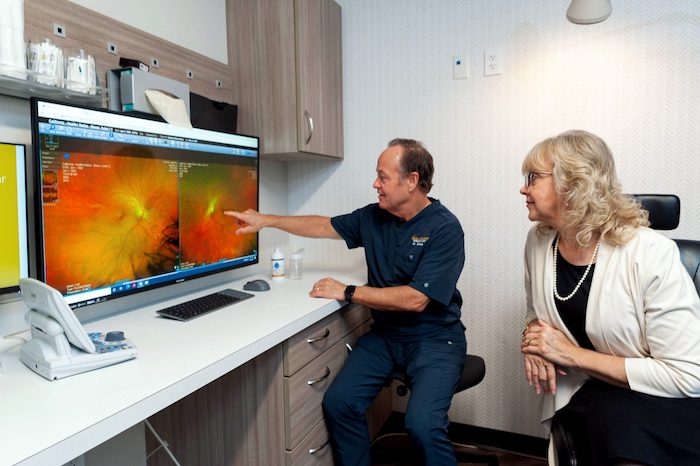Diabetic Retinopathy
A serious complication of diabetes that can lead to blindness.
 According to the Center for Disease Control and Prevention, nearly one-third of adults over the age of 40 with diabetes have diabetic retinopathy. And the rates are even higher among African- and Mexican-Americans.
According to the Center for Disease Control and Prevention, nearly one-third of adults over the age of 40 with diabetes have diabetic retinopathy. And the rates are even higher among African- and Mexican-Americans.
If you suffer from diabetes, call Kehoe Eye Care today or schedule an appointment online for a comprehensive eye exam.
What is diabetic retinopathy?
Diabetic retinopathy is a serious complication of diabetes that affects your eyes. It is the number one cause of vision loss in diabetic patients.
Diabetic retinopathy is caused by damage to the blood vessels of the light-sensitive tissue at the back of the eye (retina). This causes bleeding, swelling, and abnormal blood vessel growth. The longer you have diabetes and the less controlled your blood sugar is, the more likely you are to develop this eye condition.
What are the symptoms of diabetic retinopathy?
Like many other eye conditions, diabetic retinopathy often causes few (if any) symptoms in the early stages. You may only notice minor vision issues that could be attributed to other causes. Left untreated, diabetic retinopathy can lead to blindness.
Due to the fact that anyone who has type 1 or type 2 diabetes can develop diabetic retinopathy, it’s important to have regular comprehensive eye exams.
The disease typically affects both eyes. As it gets worse, you may notice symptoms such as:
- Empty or dark areas within your line of vision
- Fluctuating vision
- Dark strings and/or spots (i.e. floaters) in your vision
- Loss of vision
- Reduction in color vision
Management of your diabetes under the care of a medical professional — with a treatment plan that includes regular visits to the eye doctor — is the best way to prevent loss of vision.
Even if you are seeing your eye doctor on a yearly basis as recommended, if you notice the sudden appearance of the symptoms noted above, make an appointment right away.
What complications arise from diabetic retinopathy?
Because diabetic retinopathy causes the retina’s blood vessels to bleed and grow abnormally, vision problems are common. You could experience one or more of the following complications:
Vitreous hemorrhage
The centers of your eyes are filled with a jelly-like substance that’s clear. Blood vessels formed by diabetic retinopathy could leak into this vitreous jelly and cause floaters or even block your vision completely.
Retinal detachment
The presence of abnormal blood vessels encourages the growth of scar tissue in the retina. This could pull the retina away from its position at the back of your eye. Common symptoms of a retinal detachment include flashes of light, severe loss of vision and/or spots floating in your vision.
Glaucoma
If the abnormal blood vessels that mark the presence of diabetic retinopathy grow into your eye’s front area, they could block the normal flow of fluid from your eye. The result could be glaucoma which is an increase in the eye’s pressure. You might experience damage to the optic nerve if it’s left untreated.
Blindness
Over time, diabetic retinopathy, or its complications, could cause you to completely lose your ability to see.
At Kehoe Eye Care, we are committed to helping our patients enjoy exceptional vision throughout their lifetime. Call us today or schedule an appointment online to learn more about diabetic retinopathy and how we can help.
